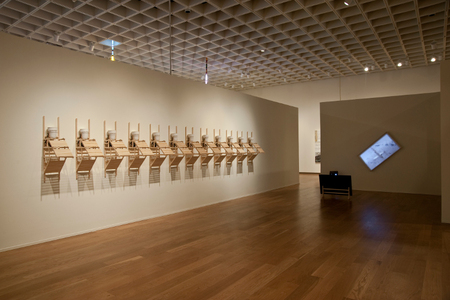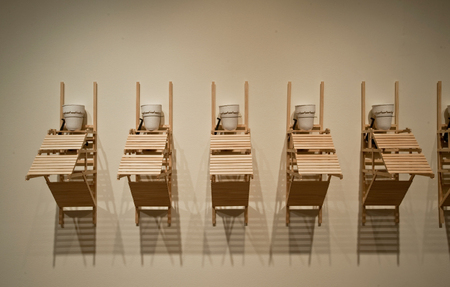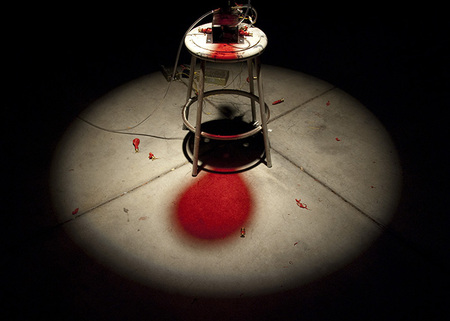Machine Performances
One Dies, Get Another



One Dies, Get Another is an installation of twelve electromechanical sculptures – each constructed from Southern Yellow Pine, plaster, forged steel, pine tar, and a microcontroller-driven motor. Twelve forged steel replicas of turpentining tools (“hacks”) rap against twelve cast-plaster replicas of terracotta turpentine collection pots (“Herty pots”). A staccato rhythm develops as each sculpture moves at its own pace, pauses, and returns to its never-ending task. The ideas driving the piece result from my three years of research into the history of the turpentine industry in North Florida and the intertwined politics of convict leasing, wartime Naval stores, and post-slavery debt peonage.
This work was installed at the Orlando Museum of Art, as part of the Florida Prize in Contemporary Art exhibition.
Photo credits: Raymond Martinot (courtesy of Orlando Museum of Art)
BANG





BANG is a kinetic sculpture automatically inflates a balloon in breaths. It continues until the balloon becomes overinflated and finally bursts. The machine ejects the brass shell to which the balloon was attached, reloads another, and continues its work. The act of over-inflating and bursting 21 balloons takes about an hour.
Exhibited at the University of California San Diego Visual Arts Performance Space, UCSD Price Center, and Prospectives.09 International Digital Arts Festival at the University of Nevada Reno.
Photos Credits: 1-3 Noah Doely; 4 Rich Bott; 5 Tim Schwartz
MOVEMENT
MOVEMENT is a machine performance by a collection of electromechanical devices. The performance is choreographed through metacomposition, in which the course of the movements, sounds, and projection are planned and executed by software in real-time. The installation continues operating autonomously for 3 hours, never repeating itself. At times the experience is quiet and meditative, while at other times, it has an intensity that shakes the performance space floor. The audience is simultaneously presented with the raw, over-engineered chaos of the electrical components, the view as seen through the frames of the magnifying glasses, an ever-changing live video projection produced by ten macroscopic video cameras, and the live sounds of the machine captured by a dozen microphones and amplified through six large loudspeakers. The performance affords the viewer a direct, tactile, physical experience of technology that contrasts with the opaque, glossy interfaces presented by the high-tech devices and systems that surround us.




TRIO
Trio is a mobile contraption that amplifies three distinct sounds produced by a small electromechanical device that it carries. Microphones capture the vibrations of a DC motor and a stepper motor, combined with the sound of wind that is alternately produced and obstructed by the machine. Each sound is dependent upon one or more of the others. The machine performs five choreographed parts.
This object was exhibited at the Susan Street Gallery in Solana Beach as part of New Contemporaries V, the San Diego ART PRIZE emerging artist’s exhibition.


Inanerumori
Inanerumori is an electronic and pneumatic installation of objects inspired by Luigi Russolo’s 1913 Futurist manifesto L’arte dei rumori (The Art of Noises). In his manifesto, Russolo argues for a new kind of music — one that reflects the noise of the industrial city, rather than the stale, artificial, and limited sounds of orchestral music. Russolo also designed a series of instruments for producing the noises required for his new Futurist music: the intonarumori.
In this installation at Grizzly Grizzly in Philadelphia, the violent, raw, brutal, and limitless spectrum of noise that Russolo’s manifesto described is toned down and limited to low-fi reproductions of mundane electronic notifications and un-alarming alerts. The large, dark, and clumsy boxes of Russolo’s intonarumori are translated into alternately flaccid and puffed-up translucent plastic forms: a smooth, clean, light(lite), and non-confrontational aesthetic of a passive and pacified culture. Russolo’s exclamation of dismissal and disgust of “via!” — aimed at the traditional orchestral music of his time — has been crudely blown up from the PDF version of the manifesto and stuck to the wall.